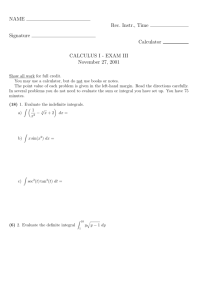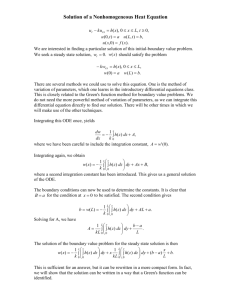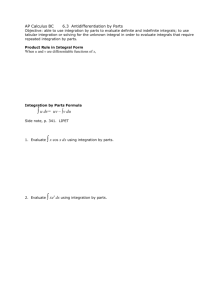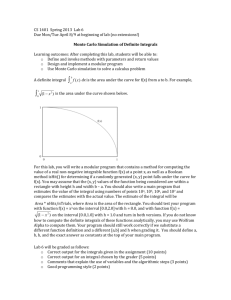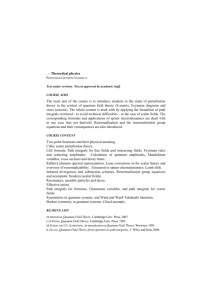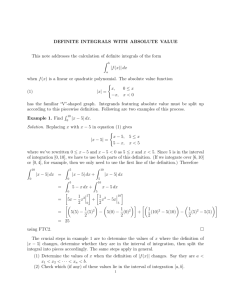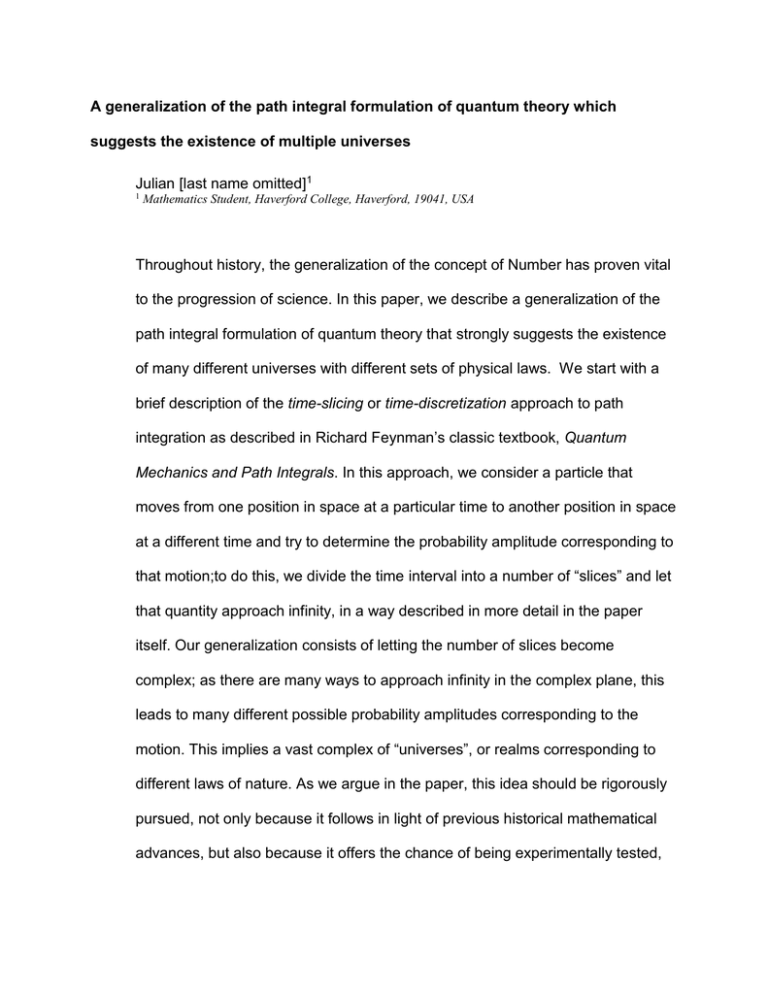
A generalization of the path integral formulation of quantum theory which
suggests the existence of multiple universes
Julian [last name omitted]1
1
Mathematics Student, Haverford College, Haverford, 19041, USA
Throughout history, the generalization of the concept of Number has proven vital
to the progression of science. In this paper, we describe a generalization of the
path integral formulation of quantum theory that strongly suggests the existence
of many different universes with different sets of physical laws. We start with a
brief description of the time-slicing or time-discretization approach to path
integration as described in Richard Feynman’s classic textbook, Quantum
Mechanics and Path Integrals. In this approach, we consider a particle that
moves from one position in space at a particular time to another position in space
at a different time and try to determine the probability amplitude corresponding to
that motion;to do this, we divide the time interval into a number of “slices” and let
that quantity approach infinity, in a way described in more detail in the paper
itself. Our generalization consists of letting the number of slices become
complex; as there are many ways to approach infinity in the complex plane, this
leads to many different possible probability amplitudes corresponding to the
motion. This implies a vast complex of “universes”, or realms corresponding to
different laws of nature. As we argue in the paper, this idea should be rigorously
pursued, not only because it follows in light of previous historical mathematical
advances, but also because it offers the chance of being experimentally tested,
might impact our understanding of the big bang and could give rise to important
future technology.
I.
A BRIEF INTRODUCTION
A very simple generalization of the path integral formulation of quantum theory
may fundamentally change science and technology. If we fully acknowledge the
existence of complex numbers -- by infusing them into Feynman’s formulation -- a
bizarre collection of parallel universes results. These universes have differing physical
laws, and -- in particular -- in these different universes conservation of energy is
violated. This application of complex numbers to Feynman’s formulation may
fundamentally changeour understanding of the laws of physics.
In this paper I shall describe this generalization of Feynman’s formulation. It
would be helpful for the reader to be familiar with the work Quantum Mechanics and
Path Integrals by Feynman himself so that she may understand my references to that
work. I must note that I am not a thoroughly educated physicist, and so I have left some
difficult problems in this theory for actual physicists to solve. However, before I describe
this theory itself, an explanation of Feynman’s formulation would be useful to provide.
A.
The Time-Discretization Approach to Path Integration
The basic idea behind Feynman’s path integral approach to quantum mechanics
is simple and elegant. To calculate the probability amplitude that any event will occur,
we add up the probability amplitudes for each way in which the event may occur. In
particular, to calculate the probability amplitude that a particle may move from one
location to another, we add up the probability amplitudes corresponding to each path
the particle may travel along. Feynman gave the contribution each path makes to the
total probability amplitude, and the only problem that remains is calculating a sum of all
the contributions of the paths.
Feynman describes in Path Integrals and Quantum Mechanics a very simple
approach to this problem [Feynman1]. First of all, it is important to note two facts: (1)
that we are considering paths through space-time, and not only through space, and (2)
that we are considering only one spatial dimension, or two dimensions when time is
included. Feynman began by considering only a discrete number of times and
corresponding positions of the particle.
FIG. 1. The time-slicing approach to path integration.
Figure 1 shows the situation: a particle moves from xa at time ta to xb at time tb.
To calculate the associated probability amplitude, we consider n discrete times and
corresponding positions of the particle. We imagine that the particle moves along
straight lines between these times.
Next, Feynman incorporates the fundamental idea of calculus – that of
approximation. We may approximate a general curved path with a path composed of
straight lines. As we increase the number of straight lines, the approximation becomes
more and more accurate. So, as we increase n in our discrete paths, they do a better
and better job of approximating a general curved path.
To carry this out, we must know the form of contribution each path makes to the
whole probability amplitude. To agree with experiments, Feynman suggested a
contribution of the form:
𝑖
exp {ℏ 𝑆}
where S is the action of the path.
Now, suppose in the straight-line paths that we label the positions of the
particle x0, x1, … xn (see Figure 1). To add up the contributions from straight-line paths
with given n, we merely integrate the contribution formula over all possible x1…xn-1. By
our previous observation, as we increase n, this answer will approach the total
probability amplitude in which all paths are taken into account. Thus, we are led to the
equation:
𝑖
𝑃 = lim ∬ … ∫ exp { 𝑆} 𝑑𝑥1 … 𝑑𝑥𝑛−1
𝑛→∞
ℏ
for the total probability amplitude of a particle moving from one location to
another.
This equation is incorrect in one very important respect.
Of course, any reader of Quantum Mechanics and Path Integrals should know
that this limit, as it stands, is utterly divergent. To force this limit to converge, and to
normalize the result (in other words, to make the integral of the probability amplitude
over all xb equal to 1), Feynman introduced a normalization constant, a function of n that
multiplies the multiple integral within the limit. Taking this important function into
account, we have:
𝑖
𝑃 = lim 𝐴(𝑛) ∫ ∫ … ∫ exp {ℏ 𝑆} 𝑑𝑥1 … 𝑑𝑥𝑛−1
𝑛→∞
(1)
It is important to note here that the integrals extend from -∞ to +∞.
B.
An Introduction to the Generalization
The generalization I wish to propose is very simple. Feynman only considered
an integer number of points of time in the straight-line paths. However, if we allow for
the existence of a complex number of “time steps” in the straight-line paths, we are led
to a profound and very startling conclusion. Figure 2 illustrates that there are many
ways in which it is possible to approach infinity in the complex plane; thus, if n in
Equation 1 is allowed to take on a complex value, many different probability amplitudes
exist for the motion. These different physical laws seemingly correspond to different
universes, each with its own laws of motion. The different ways in which n may
approach infinity would then correspond to different universes.
Now, it is a mathematical tradition to denote integers by n and non-integers
perhaps by q, so we will replace Equation 1 by:
𝑖
𝑃 = lim 𝐴(𝑞) ∫ ∫ … ∫ exp {ℏ 𝑆} 𝑑𝑥1 … 𝑑𝑥𝑞
𝑞→∞
(2)
where q is complex. This describes the infinity of possible universes according to
this generalization.
It is important that, in order for this generalization to work, the limit in equation (2)
must not exist. That is, in order for the different universes to be separate from one
another,the limit in equation (2) must not have a single value but rather must have a
multitude of values, each corresponding to a different way in which q may approach
infinity. It is certainly true that this is the case with a variety of functions of q (for
example, exp{-q}, which approaches zero on the positive real line and oscillates on the
imaginary axis), and we hope that this is the case for equation (2).
Now, the skeptic might ask, What does it even mean to integrate over a complex
number of different variables? In other words, what does the expression we wrote
above even mean? It is true that we do need to develop some sort of definition of the
process of integrating over a complex number of variables in order to give meaning to
(2). But it is still certainly possible, at least in principle, to give such a meaning, as
witness for example the fractional calculus, which defines derivatives with a fractional
order by utilizing properties kept by derivatives of an integer order [Oldham et al.2].
Indeed, we shall develop a meaning for (2) along these lines later in this paper.
To formalize the result, we note that each of the paths in Figure 2 may be
described by a parametric formula of the form 𝑥 = 𝑓(𝑡), 𝑦 = 𝑔(𝑡). Either 𝑓or
𝑔approaches infinity in the examples. Thus, we have a more formal version of
Equation 2:
𝑃=
lim
𝑓 𝑜𝑟 𝑔 𝑜𝑟 𝑏𝑜𝑡ℎ→∞
𝑖
𝐴(𝑓(𝑡) + 𝑖𝑔(𝑡)) ∫ ∫ … ∫ exp {ℏ 𝑆} 𝑑𝑥1 … 𝑑𝑥𝑓(𝑡)+𝑖𝑔(𝑡)
(3)
A number of seemingly insurmountable difficulties confront us. First of all, what
definitions shall we use to integrate over a complex number of variables? And second
of all, how would we ever test this generalization experimentally? And why should we
consider this idea, anyway? It is impossible to divide a time interval into a complex
number of pieces, isn’t it?
I shall consider the first two questions later in this paper. However, I shall now
address the last one. History has shown, again and again, that generalizing the
concept of number has proved vital in the progression of science. While complex
numbers themselves were once viewed as a numerical monstrosity, their application to
physics was essential to quantum theory. Another prime example was the concept of
negative energy which, while seeming impossible, was utilized by Dirac to develop the
very important notion of antimatter. Additionally, the fractional calculus, which defines
derivatives of non-integer orders, is becoming essential to many practical applications
[Oldham et al.2].Following these historical guides, we note that another generalization to
complex numbers may prove useful to physics. Even if the theory itself proves
incorrect, these results may become useful in other areas of science.
With that, we should begin our voyage into the generalization.
II.
Integration Over a Complex Number of Variables
We shall base the mathematics of this theory on three extremely simple axioms:
1)
Separation. This axiom will be quite critical in what follows. In fact, this
axiom has two parts: that of sums and that of products. The first part is
simple. We merely generalize the sum rule from integration, and claim that
it holds for integrals with a complex number of variables (examples will
follow in another section). The second part to this axiom is almost as
simple.
Consider the multiple integral
𝑏
𝑏
𝑏
∫ ∫ … ∫ 𝑓1 (𝑥1 )𝑓2 (𝑥2 ) … 𝑓𝑛 (𝑥𝑛 ) 𝑑𝑥1 … 𝑑𝑥𝑛
𝑎
𝑎
𝑎
Quite obviously, by the very nature of a multiple integral, this may be
written as
𝑏
𝑏
𝑏
∫ 𝑓1 (𝑥1 )𝑑𝑥1 · ∫ 𝑓2 (𝑥2 )𝑑𝑥2 … · ∫ 𝑓𝑛 (𝑥𝑛 )𝑑𝑥𝑛
𝑎
𝑎
𝑎
If all these integrals are the same, we may simply calculate a power to
get our result.
We merely assume that this law holds for multiple integrals with a
complex number of variables. These two parts to postulate 1 will be very
important to the theory, as they will allow us to integrate a vast variety of
functions, some of which that will arise in physical situations.
2)
Substitution. Many problems that arise in the context of path integration
are not, at least immediately, of a form that separation can be directly
applied to. Our strategy shall be to reduce the integrand to a simpler
expression, one that can be separated. How? With substitution, obviously!
Of course, u-substitution is a fundamental technique of integration, and is
taught in virtually all calculus courses that cover integrals. The Jacobian
becomes important when one studies u-substitution with multiple integrals,
and with each substitution, the integrand is multiplied by the Jacobian
function.
Consider the integral
∫ … ∫ 𝑓(𝑥1 … 𝑥2 ) 𝑑𝑥1 … 𝑑𝑥2
Now, suppose we make the substitution
𝑧1 = 𝑥1 − 𝑎(a is constant)
𝑧2 = 𝑥2 − 𝑥1
⋮
𝑧𝑛 = 𝑥𝑛 − 𝑥𝑛−1
(The reason why we consider this type of substitution shall be
considered later). We postulate(or,rather,define) that this substitution
corresponds to a Jacobian of 1, even when integrals are considered over
a complex number of variables. This seems quite clear, and it is certainly
true for an integer number of variables;thus, it makes sense to generalize
this to the complex.
3)
Expansion. This is very simple. Consider a sum of the form
𝑞
[∑ 𝑎𝑛 ]
𝑛=0
𝑚
where m is an integer. We merely assume that this expression is
equivalent to
𝑞
∑
𝑎𝑛1 · 𝑎𝑛2 … · 𝑎𝑛𝑚
𝑛1 …𝑛𝑚 =0
(utilizing a notation we shall use later that denotes m multiple sums). In
which q is, in general, a complex number. This is an incredibly basic
property of sums.
This postulate must be followed with a little explanation. The sums
above really are meaningless entities in and of themselves; one cannot
add up the first i integers as one might sum the first 6 square numbers.
However, when placed within a multiple integral, as the examples that
follow will show, these sums do gain a meaning. This illustrates an
important lesson: the integrands of our bizarre integrals are meaningless,
but the integrals have an actual value.
We shall use this postulate to simplify complicated integrands
involving sums, which will appear later.
Now, we come to the critical question: Why consider these axioms and none
others? It is because these axioms, dealing with the fundamental properties of
separation, substitution, and expansion, are really the simplest way to define these
integrals in a way relevant to path integration. Those three properties are really the
foundational pillars of integration and sums, and thus it makes sense to use them to
extend the definition of integration.
However, we must wonder, Why would these definitions be chosen by nature
above others? While we do not yet have the gift of experiment to determine if these are
the definitions used to define integrals in QCI theory or even if QCI theory is true, we
can speculate: history shows us that often the simplest definitions are the ones most
pertinent to nature. For example, negative numbers were defined to operate in very
simple ways so as to preserve the properties of positive numbers, and their application
to energy levels by Dirac was successful. Following these historical examples, we
define these integrals in a simple way, so as to preserve the most fundamental
properties of integrals and sums.
Incidentally, when we refer to 𝑞 𝑟 , with q and r complex, we refer to the principal
value of that quantity. This is quite clear, as this is how the integrals are defined for a
real number of variables; thus, to preserve the properties held by normal multiple
integrals, we shall use this convention.
III.
Notation and Terminology
Our notation shall be quick and efficient. Let us denote the multiple integral
𝑏
𝑏
𝑏
∫ ∫ … ∫ 𝑓(𝑥1 … 𝑥𝑞 ) 𝑑𝑥1 … 𝑑𝑥𝑞
𝑎
𝑎
𝑎
as
∫
𝑏
𝑎𝐶𝑞
𝑓(𝑥1 … 𝑥𝑞 ) 𝑑𝑖𝑣
Where we contract the original equation into a much simpler form.
I call a multiple integral over a complex number of variables a “complintegral”, for
“complex” and “integral”. Therefore I shall call this theory “Quantum
Complintegrodynamics”, as it is a quantum theory of motion.
Before we get too far into the theory, I must clear up some confusion that might
have befuddled the reader: our x1…xq take on only real values. One never measures a
particle having a “complex” position, like being i units to the left of the origin. In fact, this
theory should result in all real observable quantities. Indeed, the wavefunction is
designed so that it always gives a real answer for the probability that a particle will be
found in a given region, regardless of how “imaginary” the original wavefunction is. We
are, in fact, using complex numbers intermediately to give interesting information about
our “real” universe. Indeed, this goes along with the well-known mathematical proverb,
“The shortest path between two points in the real domain goes through the complex.”
IV.
Examples of Complintegral Calculation
Here, I will provide some examples of how the axioms above may be used to
calculate a variety of complintegrals.
Example 1. To calculate the integral
𝑞
∫
1𝐶
0 𝑞
∑ 𝑥𝑛 𝑑𝑖𝑣
𝑛=1
This is excruciatingly simple. Just apply the first part of axiom 1 to take the sum
sign out of the integral sign, yielding
𝑞
∑ ∫ 𝑥𝑛 𝑑𝑖𝑣
1
𝑛=1 0𝐶𝑞
𝑏
Now, ∫𝑏𝐶 𝑓(𝑥𝑛 )𝑑𝑖𝑣 is simply(𝑏 − 𝑎)𝑞−1 · ∫𝑎 𝑓(𝑥)𝑑𝑥 (which comes from multiplying
𝑎 𝑞
𝑓(𝑥𝑛 ) by 1𝑞−1 and applying separation), and thus, the answer is simply q.
Example 2. To calculate
𝑞
∫ ∏ 𝑥𝑛 𝑑𝑖𝑣
2𝐶
0 𝑞
𝑛=1
This is even simpler than the last problem. By axiom 2, this is simply 2 q.
This example brings up an important point. How do we know that we can just go
around, pulling products and sums out of integral signs, without worrying about
convergence? Well, notice: for real q, we may pull the product sign out of the integral.
Thus, it seems only appropriate that we may define our complintegrals to conserve that
property when generalizing to the complex(indeed, we did:that’s what axiom 2 was
about!)
Example 3. To calculate the complintegral
𝑞
∫ ∞𝐶 ∑𝑛=0 𝑒𝑥𝑝(−[𝑥𝑛+1 − 𝑥𝑛 ]2 ) 𝑑𝑖𝑣 (where 𝑥𝑞+1 is some constant, along with 𝑥0 )
−∞ 𝑞
We shall illustrate axiom 2 by using that principle to simplify this expression. We
substitute 𝑧𝑛 for 𝑥𝑛+1 − 𝑥𝑛 and obtain
𝑞−1
∫
1𝐶
0 𝑞
2
∑ 𝑒𝑥𝑝(−(𝑧𝑛 )2 ) + 𝑒𝑥𝑝 (−[𝑥𝑞+1 − 𝑥𝑞 ] ) 𝑑𝑖𝑣
𝑛=0
Now,𝑥𝑞 = 𝑧𝑞−1 + 𝑥𝑞−1 = 𝑧𝑞−1 + 𝑧𝑞−2 + 𝑥𝑞−2 = ⋯ = 𝑧𝑞−1 + 𝑧𝑞−2 … + 𝑧0 + 𝑥0 . Thus,
we have
𝑞−1
∫
1𝐶
0 𝑞
𝑞
2
∑ 𝑒𝑥𝑝(−(𝑧𝑛 )2 ) + 𝑒𝑥𝑝 (− [𝑥𝑞−1 − ∑ 𝑧𝑞−𝑛 − 𝑥0 ] ) 𝑑𝑖𝑣
𝑛=0
𝑛=1
This expression, as it turns out, may be simplified using axiom 1, by expanding
the second term in a Fourier Integral of easier-to-deal-with functions and then applying
separation. I have described this general process in detail in the section “The
Complintegrodynamical Problem of a Free Particle”, where a very similar problem
appears. Thus, I shall not waste several pages of my paper explaining a long process
that I shall describe later. Suffice it to say that axiom 2 allows us to manipulate
expressions, and bring them to a form that separation may be applied to. Of course,
separation could be applied in the very beginning of this problem; but the purpose was
not to solve it the most efficient way possible, but to illustrate axiom 2; similar
somewhat to the way ODE classes sometimes solve simple equations by complex
methods just to illustrate those procedures.
Example 4. To calculate
2
𝑞
∫ (∑ 𝑥𝑛 ) 𝑑𝑖𝑣
1𝐶
0 𝑞
𝑛=1
We use axiom 3 here. We expand the sum within the integral, yielding the result
𝑞
∫
1𝐶
0 𝑞
∑ 𝑥𝑛1 · 𝑥𝑛2 𝑑𝑖𝑣
𝑛1 ,𝑛2 =1
Now, we use axiom 1, yielding
𝑞
∑ ∫ 𝑥𝑛1 · 𝑥𝑛2 𝑑𝑖𝑣
1
𝑛1 ,𝑛2 =1 0𝐶𝑞
Now, 𝑛1 can equal 𝑛2 or not. We use this evident fact to write:
𝑞
𝑞
)2
∑ ∫ (𝑥𝑛 𝑑𝑖𝑣 +
𝑛=1
1𝐶
0 𝑞
∑
∫ 𝑥𝑛1 · 𝑥𝑛2 𝑑𝑖𝑣
1
𝑛1 ≠𝑛2 =1 0𝐶𝑞
Now, we may apply on the first term the same trick we used in example 1,
multiplying(𝑥𝑛 )2 by 1𝑞−1 and applying separation. This gives
𝑞
+
3
𝑞
∑
∫ 𝑥𝑛1 · 𝑥𝑛2 𝑑𝑖𝑣
1
𝑛1 ≠𝑛2 =1 0𝐶𝑞
Now, we may multiply 𝑥𝑛1 · 𝑥𝑛2 by 1𝑞−2 (again applying that wonderful trick),
yielding
𝑞
+
3
𝑞
∑
1
1
∫ ∫ 𝑥𝑦𝑑𝐴
𝑛1 ≠𝑛2 =1 0
0
or
𝑞
1
+ (𝑞 2 − 𝑞) ·
3
4
Which is our answer. It is interesting to note that when q is -1/3, the value is 0;
this bizarre mathematical result, it seems, is beyond the comprehension of mere
humans. Somehow, the “volume” under that bizarre shape is zero.
Now that we have completed the mathematical theory and illustrated the basic
postulates, the next step is to turn to physics. We now turn to the problem of the free
particle.
V.
The Quantum Complintegrodynamical Problem of a Free Particle
In Feynman’s book, one of the first situations considered is that of a free particle.
This elementary problem serves to illustrate many of the ideas Feynman developed
earlier. So, certainly, the most natural place for us to begin is with the free particle; this
will not only illustrate the theory, but help us develop a profound and amazing
conclusion later in this paper.
First, we begin with equation (2),
𝑖
𝑒𝑥𝑝 ( 𝑆) 𝑑𝑖𝑣
ћ
∞
−∞𝐶𝑞
lim 𝐴(𝑞) ∫
𝑞⟶∞
Now, we must express S (the action) in terms of 𝑥1 … 𝑥𝑞 (𝑥0 and 𝑥𝑞+1 are the fixed
endpoints, and so they will be considered constants). The action of a path, of course, is
defined by
𝑡𝑏
(3) ∫
𝑡𝑎
𝑚
(𝑥′)2 𝑑𝑡
2
for a free particle, in which 𝑡𝑎 and𝑡𝑏 are the start and end times of the path in
interest, and 𝑥′ is the rate of change of 𝑥 with respect to time. Equation (3) is written in a
rather awkward way; to apply it to our discrete paths, we must break it up into several
integrals for each straight line our path is composed of. Carrying this process out, we
obtain
𝑞
𝑡𝑛+1
∑∫
𝑛=0 𝑡𝑛
𝑚 (𝑥𝑛+1 − 𝑥𝑛 )2
𝑑𝑡
2
𝜀2
Where 𝑡0 … 𝑡𝑞+1 are the times associated with 𝑥0 … 𝑥𝑞+1 , and ε is the time interval
between 𝑡𝑛 and 𝑡𝑛+1 . Now, calculating the integral, we have
𝑞
𝑞
𝑛=0
𝑛=0
𝑚 (𝑥𝑛+1 − 𝑥𝑛 )2
𝑚 (𝑥𝑛+1 − 𝑥𝑛 )2
∑
·𝜀 = ∑
2
𝜀2
2
𝜀
Now, we have written the action of the discrete paths in terms of 𝑥0 … 𝑥𝑞+1 . So,
we may insert this expression for the action into equation (2), yielding
𝑞
𝑖𝑚
lim 𝐴(𝑞) ∫
𝑒𝑥𝑝 (
∑(𝑥𝑛+1 − 𝑥𝑛 )2 ) 𝑑𝑖𝑣
𝑛→∞
2ћ𝜀
∞𝐶
−∞ 𝑞
𝑛=0
Now we have a standard complintegral. Noticing the 𝑥𝑛+1 − 𝑥𝑛 term, we use our
substitution axiom (this is why we took special note of this particular substitution, so that
axiom 2 is now tailor-made to this problem). Thus, we substitute 𝑧𝑛+1 for 𝑥𝑛+1 − 𝑥𝑛 ,
yielding
𝑞−1
𝑖𝑚
𝑖𝑚
2
lim 𝐴(𝑞) ∫
𝑒𝑥𝑝 (
∑(𝑧𝑛+1 )2 +
(𝑥𝑞+1 − 𝑥𝑞 ) ) 𝑑𝑖𝑣
𝑞→∞
2ћ𝜀
2ћ𝜀
∞
−∞𝐶𝑞
𝑛=0
Now, using the same reasoning as in example 3, we note that
𝑥𝑞 = 𝑧𝑞 + 𝑥𝑞−1 = 𝑧𝑞 + 𝑧𝑞−1 + 𝑥𝑞−2 = ⋯ = 𝑧𝑞 + 𝑧𝑞−1 + 𝑧𝑞−2 … + 𝑥0
Thus, we have the complintegral
𝑞−1
𝑞−1
𝑛=0
𝑛=0
2
𝑖𝑚
𝑖𝑚
lim 𝐴(𝑞) ∫
𝑒𝑥𝑝 (
∑(𝑧𝑛+1 )2 +
[𝑥
− ∑ 𝑧𝑞−𝑛 − 𝑥0 ] ) 𝑑𝑖𝑣
𝑞→∞
2ћ𝜀
2ћ𝜀 𝑞+1
∞
−∞𝐶𝑞
Now, we may break up the exponential, yielding
𝑞−1
𝑞−1
𝑛=0
𝑛=0
2
𝑖𝑚
𝑖𝑚
lim 𝐴(𝑞) ∫
𝑒𝑥𝑝 (
∑(𝑧𝑛+1 )2 ) 𝑒𝑥𝑝 (
[𝑥𝑞+1 − ∑ 𝑧𝑞−𝑛 − 𝑥0 ] ) 𝑑𝑖𝑣
𝑞→∞
2ћ𝜀
2ћ𝜀
∞𝐶
−∞ 𝑞
This brings up a very important point: How do we know that these bizarre
complintegral exponentials behave like their real counterparts? The answer is simple:
we define them to be so. After all, we are free to choose how these exponentials act; so
let us define them in a way so as to preserve the properties of the real exponentials.
Here will be our strategy: we shall expand the rightmost exponential into a
Fourier Integral (eliminating the troublesome squared term) and apply separation. This
will tell us, eventually, how complintegrodynamical considerations affect the problem of
the free particle.
Carrying out this strategy, we write
2
𝑞−1
𝑒𝑥𝑝 (
𝑖𝑚
[𝑥
− ∑ 𝑧𝑞−𝑛 − 𝑥0 ] ) =
2ћ𝜀 𝑞+1
𝑛=0
1
√2𝜋
𝑞−1
∞
∫ 𝐹(𝑘)𝑒𝑥𝑝 (𝑖𝑘 [𝑥𝑞+1 − ∑ 𝑧𝑞−𝑛 − 𝑥0 ]) 𝑑𝑘
−∞
𝑛=0
where
𝐹(𝑘) =
1
√2𝜋
∞
∫ 𝑒𝑥𝑝 (
−∞
𝑖𝑚 2
𝑥 ) 𝑒𝑥𝑝(−𝑖𝑘𝑥)𝑑𝑥
2ћ𝜀
Now, we may carry out this integral, yielding
𝜋
√
− 2ћ𝜀
𝑖𝑚
𝑒𝑥𝑝 (−
(−𝑖𝑘)2
𝑖𝑚
4 2ћ𝜀
)·
1
√2𝜋
Simplifying, we calculate
√𝑖
2ћ𝜀𝜋
ћ𝜀𝑘 2
1
𝑒𝑥𝑝 (−𝑖
)·
𝑚
2𝑚
√2𝜋
Now that we have our Fourier Integral, we may carry out the plan. This yields
∞
𝑒𝑥𝑝 (−𝑖
lim 𝐴(𝑞) ∫
𝑞→∞
−∞
ћ𝜀𝑘 2
) √𝑖
2𝑚
2ћ𝜀𝜋
𝑚
√2𝜋
𝑞−1
𝑖𝑚
∫
𝑒𝑥𝑝 (
∑(𝑧𝑛+1 )2 )
2ћ𝜀
∞𝐶
−∞ 𝑞
𝑛=0
𝑞−1
· 𝑒𝑥𝑝 (𝑖𝑘 [𝑥𝑞+1 − ∑ 𝑧𝑞−𝑛 − 𝑥0 ]) 𝑑𝑖𝑣 𝑑𝑘
(4)
𝑛=0
In which we have taken the Fourier Integral out of the complintegral. To calculate
the complintegral within,
𝑞−1
𝑞−1
𝑛=0
𝑛=0
𝑖𝑚
∫
𝑒𝑥𝑝 (
∑(𝑧𝑛+1 )2 ) · 𝑒𝑥𝑝 (𝑖𝑘 [𝑥𝑞+1 − ∑ 𝑧𝑞−𝑛 − 𝑥0 ]) 𝑑𝑖𝑣
2ћ𝜀
∞𝐶
−∞ 𝑞
we shall utilize axiom 1. First, we combine the two exponentials, yielding
𝑞−1
𝑞−1
𝑛=0
𝑛=0
𝑖𝑚
∫
𝑒𝑥𝑝 (
∑(𝑧𝑛+1 )2 + 𝑖𝑘 (𝑥𝑞+1 − ∑ 𝑧𝑞−𝑛 − 𝑥0 )) 𝑑𝑖𝑣
2ћ𝜀
∞𝐶
−∞ 𝑞
and utilize separation. To this effect, let us combine the two sums,
𝑞−1
∫
𝑒𝑥𝑝 (∑ [
∞
−∞𝐶𝑞
𝑛=0
𝑖𝑚
(𝑧 )2 − 𝑖𝑘𝑧𝑞−𝑛 ] + 𝑖𝑘𝑥𝑞+1 − 𝑖𝑘𝑥0 ) 𝑑𝑖𝑣
2ћ𝜀 𝑛+1
Obviously, this is equivalent to
𝑞−1
∫
𝑒𝑥𝑝 (∑ [
∞
−∞𝐶𝑞
𝑛=0
𝑖𝑚
(𝑧 )2 − 𝑖𝑘𝑧𝑛+1 ] + 𝑖𝑘(𝑥𝑞+1 − 𝑥0 )) 𝑑𝑖𝑣
2ћ𝜀 𝑛+1
Taking the sum out of the exponential term, we have
𝑞−1
𝑖𝑚
(𝑧𝑛+1 )2 − 𝑖𝑘𝑧𝑛+1 ) 𝑑𝑖𝑣
∏ 𝑒𝑥𝑝 (
2ћ𝜀
∞𝐶
−∞ 𝑞
𝑒𝑥𝑝(𝑖𝑘[𝑥𝑞+1 − 𝑥0 ]) ∫
𝑛=0
Applying separation, we produce
∞
𝑖𝑚 2
𝑒𝑥𝑝(𝑖𝑘[𝑥𝑞+1 − 𝑥0 ]) (∫ 𝑒𝑥𝑝 (
𝑥 − 𝑖𝑘𝑥) 𝑑𝑥)
2ћ𝜀
−∞
𝑞
Now, evaluating the integral, we have
𝑞
𝑒𝑥𝑝(𝑖𝑘[𝑥𝑞+1 − 𝑥0 ]) (√
𝜋
𝑖𝑚
− 2ћ𝜀
𝑒𝑥𝑝 (−
(−𝑖𝑘)2
𝑖𝑚
4 2ћ𝜀
)·
1
√2𝜋
)
This allows us to “simplify” equation 4 to
∞
lim 𝐴(𝑞) ∫
𝑞→∞
1
−∞ √2𝜋
·√
2𝑖ћ𝜀𝜋
𝑚
𝑞
𝜋
· (√ 𝑖𝑚 ) 𝑒𝑥𝑝 (𝑖𝑘(𝑥𝑞+1 − 𝑥0 )) 𝑒𝑥𝑝 (−
− 2ћ𝜀
𝑖𝑘 2 ћ𝜀(𝑞 + 1)
) 𝑑𝑘
2𝑚
𝑞
2𝑖ћ𝜀𝜋
Now, since√
𝑚
· (√
𝜋
−
) does not depend on k, it may be removed from the
𝑖𝑚
2ћ𝜀
integral. Now, notice this: in Quantum Theory, of course, a constant factor in a kernel
(as Feynman calls this probability amplitude; see his book) may be disregarded. So
we may immediately disregard those expressions mentioned just above. Now, what
really matters in the kernel is the dependence on the end points. This involves the
𝑒𝑥𝑝(𝑖𝑘[𝑥𝑞+1 − 𝑥𝑞 ]) expression. Now, the other exponential factor is “intertwined”, so
to speak, within the integral with the spacial dependence factor, so we can not ignore
it so quickly. However, in that expression, the ε cancels with the q+1, and thus it does
not depend on q. This means, of course, that the free particle scenario is
equivalent for all Quantum Complintegrodynamical universes.
This result is, of course, a bit disappointing. It may lead us to believe that all
Quantum Complintegrodynamical universes are entirely equivalent. But do not jump
to conclusions; adding a potential, it seems, will disrupt the perfect canceling that
conspired to make the free particle situation equivalent for all complintegrodynamical
universes. In the next section, we shall make this quantitative by solving the particle
in a potential problem.
VI.
The Quantum Complintegrodynamical Problem of a Particle in a Potential
First, of course, we shall need to find the action of the discrete paths. Following
the same procedure as in the last section, we calculate
𝑞
𝑏
𝑡𝑛+1
𝑚
𝑚 (𝑥𝑛+1 − 𝑥𝑛 )2
2
(𝑥′) − 𝑉(𝑥)𝑑𝑡 = ∑ ∫
∫
− 𝑉(𝑥)𝑑𝑡
2
𝜀2
𝑎 2
𝑡𝑛
𝑛=0
𝑞
𝑡𝑛+1
𝑚 (𝑥𝑛+1 − 𝑥𝑛 )2
= ∑[
−∫
𝑉(𝑥) 𝑑𝑡]
2
𝜀
𝑡𝑛
𝑛=0
Now, if we imagine a discrete path, we see that 𝑥(𝑡) = 𝑥𝑛 +
𝑥𝑛+1 −𝑥𝑛
𝑡𝑛+1 −𝑡𝑛
𝑡 in the
interval [𝑡𝑛 , 𝑡𝑛+1 ]. So, applying this to the expression above, we obtain
𝑞
𝑡𝑛+1
𝑚 (𝑥𝑛+1 − 𝑥𝑛 )2
𝑥𝑛+1 − 𝑥𝑛
∑[
−∫
𝑉 (𝑥𝑛 +
𝑡) 𝑑𝑡]
2
𝜀
𝑡𝑛+1 − 𝑡𝑛
𝑡𝑛
𝑛=0
Now, if we put this action into equation (2), we get
𝑞
𝑡𝑛+1
𝑖
𝑚 (𝑥𝑛+1 − 𝑥𝑛 )2
𝑥𝑛+1 − 𝑥𝑛
lim 𝐴(𝑞) ∫
𝑒𝑥𝑝 ( ∑ [
−∫
𝑉 (𝑥𝑛 +
𝑡) 𝑑𝑡]) 𝑑𝑖𝑣
𝑞→∞
ћ
2
𝜀
𝑡𝑛+1 − 𝑡𝑛
∞
𝑡𝑛
−∞𝐶𝑞
𝑛=0
Now, in Feynman’s own book, this problem is solved by expanding the
exponential in a Taylor Series. Following this idea, we simplify the expression to
𝑣
∞
𝑞
𝑣=0
𝑛=0
𝑡𝑛+1
𝑚 (𝑥𝑛+1 − 𝑥𝑛 )2
𝑥𝑛+1 − 𝑥𝑛
lim 𝐴(𝑞) ∑ 𝑎𝑣 ∫ {∑
−∫
𝑉 (𝑥𝑛 +
𝑡) 𝑑𝑡} 𝑑𝑖𝑣
𝑟,𝑞→∞
2
𝜀
𝑡𝑛+1 − 𝑡𝑛
𝑟
𝑡𝑛
−𝑟𝐶𝑞
Here’s where axiom 3 comes in handy. Utilizing that postulate, we write
𝑞
∞
𝑞
lim 𝐴(𝑞) ∑ 𝑎𝑣 ∑ ∑ … ∑
𝑟,𝑞→∞
𝑣=0
𝑎1 =0 𝑎2 =0
𝑎𝑣 =0
𝑡𝑛+1
−∫
𝑡𝑛
𝑎𝑣
𝑞
𝑉 (𝑥𝑛 +
∫
𝑟
−𝑟𝐶𝑞
∏[
𝑛=𝑎1
𝑚 (𝑥𝑛+1 − 𝑥𝑛 )2
2
𝜀
𝑥𝑛+1 − 𝑥𝑛
𝑡) 𝑑𝑡] 𝑑𝑖𝑣
𝑡𝑛+1 − 𝑡𝑛
(5)
(We write a limit as r approaches infinity instead of writing out the improper
integrals explicitly in order to avoid divergence). There seems to be a difficulty here:
what of the v=0 case? It seems that this term must be computed separately from the
rest by using the expression above equation (5), as (5) itself gives us little meaning
for this term.
Now, notice, we may use the trick from example 4 to evaluate this expression to
many degrees of approximation. This expression, as it stands, is meaningful. Thus,
although we may not be able to entirely evaluate expression 4, we have solved the
problem by reducing it to a meaningful expression.
To see why this is the case, we must look back at example 4. Consider a value of
v and the corresponding term in the expansion of (5). How did we derive this term? If
we trace back our derivation, and in particular look back to the equation above (5),
we see a striking similarity between this problem and example 4. Both involved
reducing a sum raised to a power into a series of nested sums, and it seems both
problems may be analyzed using the same procedure: First, reduce the sum-to-apower into nested sums; then, break up the integral that results into several portions;
then, calculate the portions using our axiom 1 trick; and finally, replace the sums with
easier-to-use products. The reader should look back to the example to verify this.
Thus, we may evaluate each term in the expansion with this procedure.
Therefore, one could, at least in principle, calculate the entire sum (5). Thus, we have
made great progress: we have shown that the situation of a particle in a potential is
meaningful in a complintegrodynamical framework.
So, what results can we derive from these bizarre ideas?
VII.
Comments About the Solution
First of all, although I have not yet explicitly simplified expression (5), notice that
it seems unlikely that the perfect canceling factors that conspired to make the free
particle scenario equivalent for all complintegrodynamical universes would be
disrupted by the presence of a potential term. Indeed, it seems very possible that (5)
does not have a single limit at infinity, and thus gives rise to many physical laws.
How might these physical laws be different in a complintegrodynamical
framework? Let us study first perhaps the most important physical law, conservation
of energy. Conservation of energy finds its place in quantum mechanics when we
imagine the universe as a multi-particle system, and we say that the total of all the
expectation values of the energy of all particles is exactly constant. This involves a
critical balance of all the probability amplitudes in the universe, and it seems that
complintegrodynamical considerations would disrupt this balance.
To make this quantitative, let us consider the expectation value of the energy of a
particle in quantum mechanics. It is given by the formula [Griffiths3]
∞
∫ 𝐻 𝑑𝑥
−∞
Where H is the Hamiltonian Operator and is the wavefunction of the particle.
Since conservation of energy is defined in quantum theory in terms of the expectation
value of the energy [Griffiths3], it seems quite clear that complintegrodynamical
effects, that change the wavefunction of the particle from its description in ordinary
quantum theory, will disrupt conservation of energy.
So, since all universes are equivalent for a free particle, this means that
applying a potential to a particle would generate an extra energy in a Quantum
Complintegrodynamical framework. Thus, in this theory, conservation of energy is
violated to different degrees depending on which universe you are in.
Now, this allows us to determine which universe we live in. Obviously, since no
experiments have measured the bizarre effects I mentioned, our universe must
correspond to a limit in Fig.2 which is quite close to the x-axis. We can explain this
with the anthropic principle: only universes corresponding to limits close to the x-axis
in Fig.2 could possibly sustain life. For, in the early universe, a thick maelstrom of
particles existed at incredibly high energies. This implies that the potential was high,
and therefore that much new energy was generated. This generation of extra energy
would, by the nature of the early universe, cause a chain reaction that would suffuse
the universe with a large amount of extra energy. If this energy gets generated faster
than the universe expands, then the universe would quickly heat up and crunch
together. Thus, to limit this chain reaction to allow life to form, our universe must
correspond to a limit to infinity that exists roughly on the x-axis. Unfortunately, due to
the difficult nature of equation (5), I can not make this idea quantitative.
But let us speculate. Perhaps future civilizations will one day use Quantum
Complintegrodynamics to generate vast amounts of energy. This would revolutionize
space travel, to say the least, as spacecraft would no longer need to carry fuel with
them. Perhaps this theory could hold the key to new technology.
Some readers must at this point be wondering, How will this theory be tested?
Indeed, it is the very nature of science that makes experiments central to the
establishment of a theory. Again, however, I will be prohibited to make any
quantitative claims about these experiments due to the difficulty of equation (5).
However, I can speculate: with a large enough particle accelerator, or perhaps with
more precise measurements of cosmic rays(both phenomena corresponding to high
potentials, where complintegrodynamical effects become relevant), we might observe
the creation of extra energy according to Quantum Complintegrodynamics.
VIII.
Conclusion
A very simple generalization of the path integral approach to quantum
mechanics-in which we allow a time interval to be divided into a complex number of
“slices”-predicts a vast complex of different universes, or entirely separate realities
corresponding to different laws of nature. Although we have not proven this idea
rigorously here, it seems perfectly possible that these universes do indeed have
different and alien physical laws, and may behave in ways we never thought possible.
However, we did prove that the scenario of a free particle is equivalent across all the
universes(meaning that a free particle acts in the same way in all the different
realities), meaning that the difference between these universes only becomes
manifest in the presence of a potential. We then showed that conservation of energy
probably does not apply in all universes, and in particular that applying a potential to
a particle in general generates new energy in the majority of universes.
This effects our study of the big bang, since that event took place at truly high
potentials. At the very beginning of our universe, a high-energy chaotic sea of
particles existed. Thus implies that, in general,much energy was generated. If that
energy became generated faster than the rate of expansion of the universe, life would
not form, making it easy to apply the anthropic principle to this multiverse hypothesis.
Thus, this theory not only naturally follows from previous historical mathematical
advances from the real to the complex, but also impacts our understanding of the big
bang(because the difference between universes becomes manifest at high potentials,
it seems), might be tested with observations of high potential phenomena, and is an
easy way to apply the anthropic principle. All around, it seems to be a promising
proposal and to be quite worthy of future scientific research.
Time and time again, the generalization of the concept of Number has proven
vital in the progression of science. If we work to solve equation (5), and apply this to
the anthropic principle to determine how our universe behaves, the progress in
science and technology might blow everyone away.
ACKNOWLEDGEMENTS
Dr. Michael Carchidi of Drexel University offered invaluable tutoring on theories
of physics that aided me in writing this paper. He also offered much encouragement
in developing complintegrodynamical theory.
REFERENCES
1
Richard Feynman, Quantum Mechanics and Path Integrals (McGraw-Hill, New
York, 1965) pp.32-33.
2
Keith B. Oldham and Jerome Spanier, The Fractional Calculus (Academic, New
York, 1974)
3
David J. Griffiths, Introduction to Quantum Mechanics (Pearson Prentice Hall,
Upper Saddle River, 2005) pp.17, 37.




